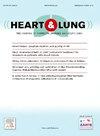Synthesis of expert opinions on fluid management in severe sepsis: A contextual review of human albumin and crystalloids
IF 2.4
4区 医学
Q2 CARDIAC & CARDIOVASCULAR SYSTEMS
引用次数: 0
Abstract
Background
Sepsis is a critical condition associated with high mortality rates that necessitates effective fluid resuscitation. Crystalloids are widely utilized; however, human albumin solutions have been attributed potential oncotic and anti-inflammatory benefits. Given the ongoing debate and the absence of definitive empirical evidence, expert opinions provide valuable insights into the contextual and practical aspects of fluid management.
Objectives
This review synthesizes expert opinions on the utilization of albumin compared to crystalloids in critically ill sepsis patients, emphasizing the contextual and practical considerations rather than drawing conclusions about clinical efficacy.
Methods
Following the Joanna Briggs Institute (JBI) guidelines for systematic reviews of text and opinions, databases and registries were searched from 2015 to 2024. Two reviewers independently screened sources. Data extraction was conducted by one reviewer and verified by another reviewer. Of 1,917 sources, 38 met the inclusion criteria. Findings were synthesized narratively.
Results
Expert consensus emphasizes crystalloids as the preferred first-line fluid for sepsis due to their safety, cost-effectiveness, and availability. Albumin is conditionally recommended in specific scenarios such as severe hypoalbuminemia, high vasopressor requirements, or volume-sensitive conditions. While theoretical benefits of albumin, including enhanced volume expansion and reduced fluid overload, are recognized, evidence for consistent clinical outcomes remains limited. Experts underscore the importance of individualized management tailored to patient-specific factors and dynamic monitoring, aligning with guideline recommendations that advise against routine albumin use.
Conclusions
This review highlights the contextual and practical aspects of fluid management in sepsis, underscoring the predominance of crystalloids as the initial choice. Expert insights suggest that albumin may have a supplementary role in specific clinical scenarios. These findings provide a refined understanding of current practice and serve as a foundation for informed decision-making and future research.
Trial Registry
PROSPERO; Registration Number: CRD42024580521; URL: https://www.crd.york.ac.uk/PROSPERO/display_record.php?RecordID=580521.
严重脓毒症中液体管理的专家意见综合:人白蛋白和晶体的背景审查。
背景:脓毒症是一种与高死亡率相关的危重疾病,需要有效的液体复苏。晶体被广泛应用;然而,人白蛋白溶液具有潜在的抗肿瘤和抗炎作用。鉴于正在进行的辩论和缺乏明确的经验证据,专家意见为流体管理的背景和实际方面提供了宝贵的见解。目的:本综述综合了专家对白蛋白与晶体蛋白在危重症脓毒症患者中的应用的意见,强调背景和实际考虑,而不是得出临床疗效的结论。方法:根据乔安娜布里格斯研究所(Joanna Briggs Institute, JBI) 2015 - 2024年的文献和观点系统综述指南,检索数据库和注册库。两名审稿人独立筛选来源。数据提取由一位审稿人进行,并由另一位审稿人进行验证。在1,917个来源中,38个符合纳入标准。研究结果以叙述的方式综合。结果:由于其安全性、成本效益和可获得性,专家一致强调晶体是败血症首选的一线液体。白蛋白有条件地被推荐用于特殊情况,如严重的低白蛋白血症、高血管加压素需求或容量敏感的情况。虽然白蛋白在理论上的好处,包括增强体积扩张和减少液体过载,是公认的,但一致的临床结果的证据仍然有限。专家强调个性化管理的重要性,针对患者的具体因素和动态监测,与反对常规使用白蛋白的指南建议保持一致。结论:这篇综述强调了脓毒症中液体管理的背景和实践方面,强调了晶体作为首选的优势。专家的见解表明,白蛋白可能在特定的临床情况下具有补充作用。这些发现提供了对当前实践的精细化理解,并为知情决策和未来研究奠定了基础。试验注册:PROSPERO;注册号:CRD42024580521;URL: https://www.crd.york.ac.uk/PROSPERO/display_record.php?RecordID=580521。
本文章由计算机程序翻译,如有差异,请以英文原文为准。
求助全文
约1分钟内获得全文
求助全文
来源期刊

Heart & Lung
医学-呼吸系统
CiteScore
4.60
自引率
3.60%
发文量
184
审稿时长
35 days
期刊介绍:
Heart & Lung: The Journal of Cardiopulmonary and Acute Care, the official publication of The American Association of Heart Failure Nurses, presents original, peer-reviewed articles on techniques, advances, investigations, and observations related to the care of patients with acute and critical illness and patients with chronic cardiac or pulmonary disorders.
The Journal''s acute care articles focus on the care of hospitalized patients, including those in the critical and acute care settings. Because most patients who are hospitalized in acute and critical care settings have chronic conditions, we are also interested in the chronically critically ill, the care of patients with chronic cardiopulmonary disorders, their rehabilitation, and disease prevention. The Journal''s heart failure articles focus on all aspects of the care of patients with this condition. Manuscripts that are relevant to populations across the human lifespan are welcome.
 求助内容:
求助内容: 应助结果提醒方式:
应助结果提醒方式:


